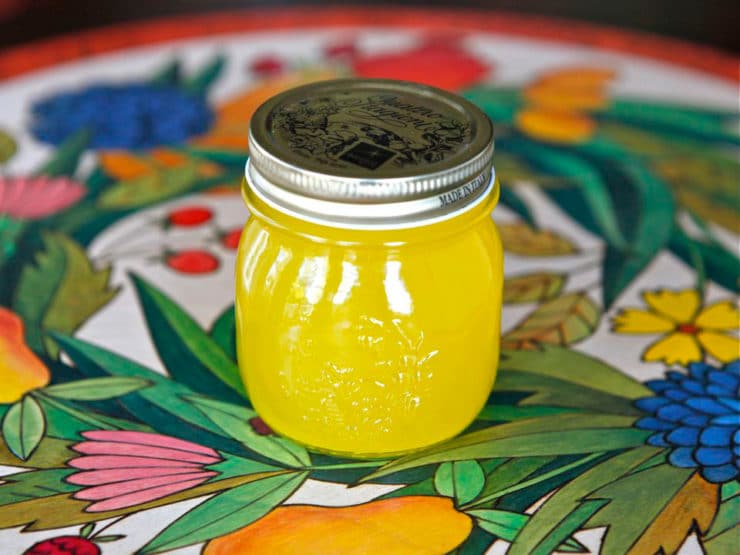
Clarified butter, also sometimes referred to as drawn butter, is a form of “clean” butter where certain solids are removed and only the pure butterfat remains. Unsalted butter is slowly melted, allowing the milk solids to separate from the transparent golden liquid and for any water to evaporate. Cooking with clarified butter has several benefits, particularly when frying. Milk solids are what cause butter to smoke and burn in cooking, so by omitting them, you are able to cook with butter at a much higher temperature and for a longer period of time. Milk solids also cause the butter to spoil, or become rancid. Clarifying the butter ensures that when you use it to cook certain things they will have a longer shelf life.
The taste of clarified butter, though different and less rich than regular butter, is great for frying certain foods, like breaded eggplant, pancakes or blintzes. It has a nice, subtle flavor that you won’t get when frying in animal fats or other types of oil. If you’re learning to cook kosher, clarified butter is useful in dairy and vegetarian dishes, but should not be used to cook meat.
Clarified butter does not become grainy when refrigerated and re-melted. It is a popular choice with certain baked goods. It’s also helpful when creating a smooth hollandaise sauce. Because most of the milk solids are removed, clarified butter is also a good choice for people with lactose intolerance. Those who have milk allergies, however, should steer clear because of the small amount of milk solids that may remain.
Making your own clarified butter is very simple. I will walk you through the process here. I’ve written the tutorial for 1 cup of butter, which produces between 2/3 cup and 3/4 cup clarified butter. You can easily double or triple the recipe to make more at a time. I like to make 2 or 3 cups and store in the refrigerator, so I always have some on hand. It will last you several months.
Next week, I’ll share a recipe where you’ll need to know this process… so study up! 🙂
Recommended Products:
We are a participant in the Amazon Services LLC Associates Program, an affiliate advertising program designed to provide a means for us to earn fees by linking to Amazon.com and affiliated sites. As an Amazon Associate I earn from qualifying purchases.
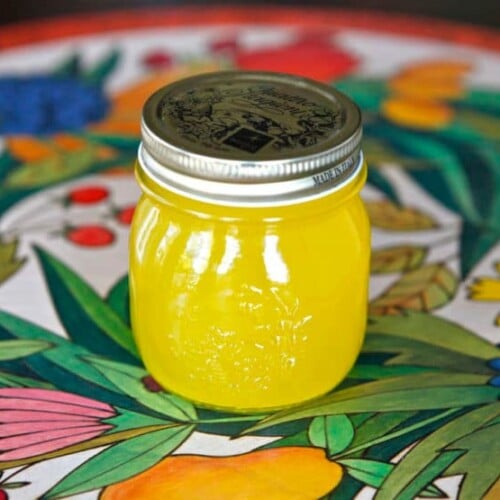
How to Clarify Butter
Ingredients
- 1 cup unsalted butter (2 sticks)
- Small saucepan
- Mesh strainer
- Several layers of cheesecloth
- Heat-safe bowl
- Sealed container for storing the clarified butter (I use a small mason jar)
Instructions
- Place butter into a small, heavy-bottomed pan. Turn heat to medium-low. Let the butter melt slowly. This will take a few minutes-- don't rush it by raising the heat. Low and slow is the way to go! Don't stir the butter as it melts, just let it be.

- Once the butter is completely melted, you'll notice a foamy white layer has formed on the top. Use a spoon to skim that foam from the surface of the butter, being careful to leave behind the golden butterfat.

- Skim as much of the foam as possible from the surface. Don't worry if a few specks are left behind, you will strain those away later. If you'd like, you can use the solids you have skimmed in another dish to add flavor-- it can be tossed with warm pasta, on rice, or on fresh hot popcorn.

- Remove the butter from heat and allow to rest for 5 minutes. Meanwhile, place a wire mesh strainer over a heat-safe bowl. Line the strainer with several layers of cheesecloth. If you don't have cheesecloth on hand, use a coffee filter-- it will take longer to strain through, but it's just as effective.

- Tilt the pan gently and slowly pour the melted butter through the cheesecloth. You only want to pour the golden fat through the cheesecloth, skimming away the leftover bits of foam.

- When you get to the bottom of the pan, you'll notice more milk solids. Do not pour those through the cheesecloth-- stop when you run out of butterfat and only the solids remain.

- Pour clarified butter into a container and seal. Store in the refrigerator. Butter will solidify at cooler temperatures, but can easily be returned to liquid by warming.

Nutrition

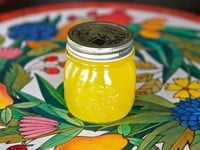
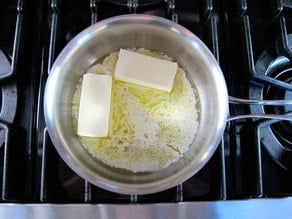

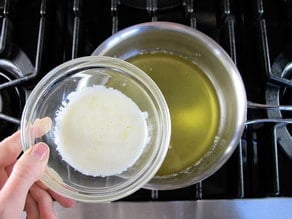
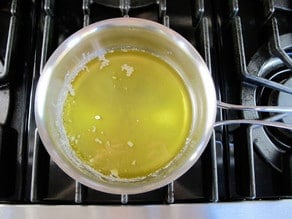
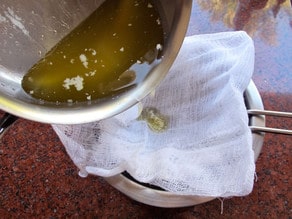
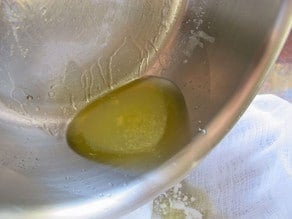
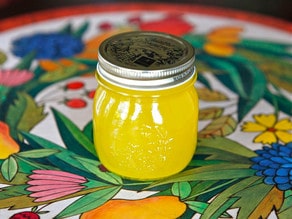


Drawn butter is not the same thing as clarified butter. Drawn butter is just melted butter that has not been clarified.
There is some disagreement on this point between chefs– some use the term drawn butter to describe clarified, while others refer to simple melted butter as drawn.
Can cheesecloth be washed and reused?
I never do because I worry about food particles getting caught in the small holes and causing spoilage. If you want a reusable alternative, I suggest getting a batch of linen towels, which can be washed and reused in the same way cheesecloth is.
You can reuse the cheesecloth. First wash it in hot water (no soap). Then microwave it for about 30 seconds and all bacteria will be killed.
Just made this thanks to your informative and step by step instructions. I had read many articles about the benefits of ghee over butter and other oils. I think I made the ghee as I let it cook until it was completely clear and slightly toasted. I am excited to use it!!
This is how I do it also. I started buying ghee when I found I was allergic to casein, but I don’t like the taste of bottled ghee and making it myself is a hassle, having to cook it for a long time and watch it carefully so it doesn’t burn. It finally dawned on me that I could simply gently melt the butter and skim/filter the milk solids off once they’d separated. Granted, not as much water evaporates that way, and so it is technically less shelf-stable than ghee, but I use it quickly enough that it doesn’t matter. And I personally prefer the taste of clarified butter, it is more like regular butter.
Can i use salted butter? or will it have a different outcome?
Hi Angela, Tori’s assistant Ashley here! You can use salted butter if you’d prefer, though most people prefer not to since you won’t be able to adjust the saltiness of the final result.
This is a little late to help you, Angela, but I just clarified salted butter (I was going to use it to make Ethiopian kitfo, so I didn’t mind if it would be salty). Surprisingly, practically all of the salt became concentrated foamy milk layer that you skim off–I couldn’t detect saltiness in the clarified butter! Hopefully this will help someone in the future.
Enjoyed this instruction, thankyou.
Hi, Tory.
I was wondering, are you using a slotted spoon to skim the foam from the oil?
Hi Gregory– nope, just a plain large shallow metal spoon. The metal is thin so easier to skim a thin layer than with a thicker wooden spoon.
I have just discovered this very informative and interesting website. thank you for being so dedicated and generous with your knowledge and expertise.
When I make clarified butter I don’t skim off the foam I let it burn at the bottom of the pan. It snap crackles and pops and when it stops do this it is done. I then filter the oil through a a paper towel. When I have used a coffee filter it takes too long to flow through so I use the paper towel which flows through like if you used cheese cloth. I then store it in small glass jars to use when needed. I read if you store in the refrigerator it ruins the butter, is this true? As you said it has a long shelf life. When I see it in stores it is on the shelf without refrigeration since it does have a long shelf life. What is left on the bottom of the pan is the burnt (not black burnt but brown) solids not needed and what is not good for you. What you get is the yellow clarified butter with it’s rich taste I love using on my toast, french toast, pancakes and use in cooking. Much better than real butter.
Just a thought from my organic kitchen… Be careful using paper towels! When i worked as a chef we weren’t aloud to have them make contact with food. Most contain harmful chemicals that you don’t want leaching into your butter. I use unbleached coffee filters & wait patiently or unbleached cheese cloth (which is hard to find).
Hi Michael, I’m getting ready to make my first batch, and came across another website (altonbrown.com) that says “Both clarified butter and ghee begin with melting over low heat. And they are both heated until the water evaporates and the milk solids settle and then the clear fat is poured off. Ghee is heated just a wee bit more until the milk solids are browned, giving the resulting fat a nutty flavor and aroma. The difference is subtle.” And here I thought they were the same thing. I guess you learn something new every day!
Tori, you are now my first and immediate go-to source for how to do stuff like this! This past weekend, my husband and I were reading about some high-falluting (in the south we omit the final “g” for pronounciation) hamburger and what are normally called “french fries” were referred to as “potato renditions” by the restaurant. Seriously?! Leave it to a NYC restaurant to be so pretentious as to not lower itself to serve french fries! LOL! The article is here (http://www.thedailymeal.com/40-best-burgers-america), and the restaurant spoken of is #2 on the list. The article has some good burger history if you wanted to do one of your food history articles and have not yet included this culinary masterpiece so eloquently described on an episode of How I Met Your Mother (“Just a Burger? Just a burger. Robin, it’s so much more than “just a burger.” I mean…that first bite—oh, what heaven that first bite is. The bun, like a sesame freckled breast of an angel, resting gently on the ketchup and mustard below, flavors mingling in a seductive pas de deux. And then…a pickle! The most playful little pickle! Then a slice of tomato, a leaf of lettuce and a…a patty of ground beef so exquisite, swirling in your mouth, breaking apart, and combining again in a fugue of sweets and savor so delightful. This is no mere sandwich of grilled meat and toasted bread, Robin. This is God, speaking to us in food.” )
So anyway, I figured no cook out there could be any more pretentious than Julia Child so I found her Pommes Parisienne recipe (http://blog.rouxbe.com/pommes-parisienne-delicious-fried-potatoes/) and, since the potato plant is related to the nightshade (according to wikipedia), I shall call this recipe Nightshade Renditions, as it has such a mysteriously ominous sound to it.
However, the little potato balls should be cooked in clarified butter, and, let’s just say a good old Texas girl like me needed some clarification! I also just realized the meat/dairy combination, but as this Texas Shikssa says, Kosher Schmosher! This is Texas, we don’t eat soy!
So, again, not to be redundant, but I find myself thanking you once again for the great hints and tips. Tomorrow I will be making some wonderful burgers served on a bun, like a sesame freckled breast of an angel…oh, heck, you’ve already heard it! But I’ll be making challah buns and serving Nightshade Renditions on the side.
With Ketchup!
I know this was written in 2013, but i just read it here in 2017. Prissinboot you just gave me my chuckle of the day. I totally loved your rendition. Thank you
Thank you so much for showing how to clarify butter with these nice pictures. It is so easy to understand in how you explain it, I will try this out.
By the way, I have been browsing your site and I love it, you have a new fan.
I will keep on visiting.
Warmly,
Thordur
I’m originally from India and ghee is a must for our recipes! It really makes such a difference in flavor, I’ve never tried to make it on my own, but maybe I’ll try now!
Thank you ever so much for the visuals. The ghee is perfect for those crazy “Asian Mish-mashes” whipped up late at night. Ghee with spritzes of sesame/hot pepper oils, scallops, slivers of bell peppers, cashews, baby bellos, left-over cooked rice, green onions, and pinches of goram masala are helping convince the grandkids there’s more to life than fast food “Breakfast Chem-burgers.” I am looking forward to using it as the oil in the bread recipes. In Gassho & L’ Chaim!
OMG this sounds so delish!!! I must try it! Thanks you!
Love all your recipes and share them with my daughter in law
who lives in Israel.
Thank you.
I came by my understanding decades ago at a temple and you are absolutely right it is all a matter of opinion and preference. The country and area is beautifully diverse and rich. I look forward to your post on the browned ghee! As always love your updates and site!
Thanks Ber! Would love for you to share your crockpot method here.
Also technically ghee is a class of clarified butter and is richer and gold to brown in color not yellow. In Indian recipes the substitution is not ideal but works if you can’t get real ghee. In fact a lot of what is sold as ghee is not really ghee any longer but a cheaper clarified butter. Just for ‘clarification’ purposes. lol
According to my Indian friend not all ghee is browned, but you can allow it to cook longer and slower for a browned, toasted flavor. It’s a matter of preference. I plan to cover browned butter and browned ghee in a future post. 🙂
First as for being better yes, it has a few key cancer fighting acids but is also casein free since all the protein bits or solid bits have been removed. I am vegan save Ghee. Which I do myself and can. First I do mine in my crock pot and loooove the brown ghee!!! OMG!! It takes time, hence the crock pot, but there it is nothing short of heaven. Don’t waste the solids if you are not watching the casein’s mix with a bit of powdered sugar for a great addition to cookies, topping ice cream etc. Yes, you can can ghee easily. While still hot put into sterile jars leaving only a fraction of a head, quarter inch tops, and seal with sterile two piece rings.
Thanks for showing how to clarify butter. The response I get to my question, “How do you clarify butter?”; is usually, “You cook it.”
Is clarified butter supposed to be healthier for you? I live in India and am told that often. Just wondering if you know?
Hi Amy, great question! Clarified butter is basically fat, like butter, so while I wouldn’t consider it a “health food” persay, it does have certain benefits that can make it a better choice than butter. It has most of the lactose removed, which is helpful for those who are lactose intolerant. It has a higher smoke point than butter, which means you can cook with it without creating dangerous free radicals. It also aids in digestion; as a purer form of fat than butter, it can stimulate the secretion of stomach acids, whereas butter and other dairy products tend to slow the digestive process. It also contains more short chain fatty acids than butter, and it’s rich in antioxidants. Hope that helps!
Do you actually seal the gee or do you just put a cover on the jar and put it in the fridge
Great step-by-step instructions! Is it possible to freeze it as well?
Hi Koji, yes. Clarified butter has quite a long shelf life– longer than regular butter, so you can keep it in the refrigerator for 3 months or longer. You can also freeze it for up to 6 months. Enjoy!
Thank you so much for showing how to clarify butter with pictures. It makes it so much clearer (no pun intended). I can finally do my own clarified butter.
Glad it was helpful to you Alisa! I clarify 2-3 cups at a time, bottle it up and refrigerate for future use so I always have some on hand.